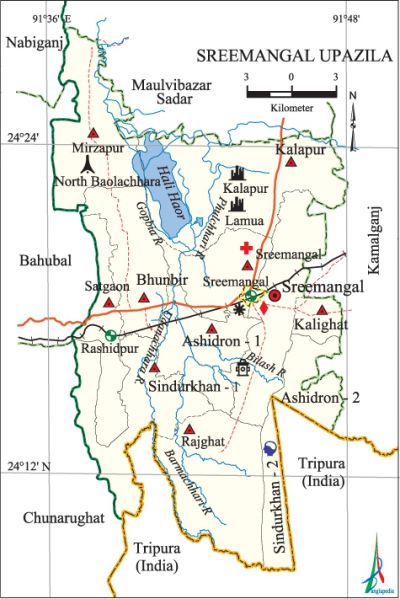Sreemangal Upazila
Sreemangal Upazila (maulvibazar district) area 450.74 sq km, located in between 24°08' and 24°28' north latitudes and in between 91°36' and 91°48' east longitudes. It is bounded by maulvibazar sadar upazila on the north, tripura state of India on the south, kamalganj upazila on the east, chunarughat, bahubal and nabiganj upazilas on the west.
Population Total 278232; male 143033, female 135199; Muslim 154341, Hindu 119516, Buddhist 4204, Christian 92 and others 79.
Water bodies Main rivers: Bilash (Gopla), Gopbia, Phulchhari, Udnachhari, Barmachhari; Hail Haor is notable.
Administration Sreemangal Thana, now an upazila, was formed in 1912. Municipality was formed in 1935.
| Upazila | ||||||||
| Municipality | Union | Mouza | Village | Population | Density (per sq km) | Literacy rate (%) | ||
| Urban | Rural | Urban | Rural | |||||
|
1 |
9 |
109 |
207 |
32506 |
258814 |
617 |
61.8 |
36.5 |
| Municipality | ||||||||
|
Area (sq km) |
Ward |
Mahalla |
Population |
Density (per sq km) |
Literacy rate (%) | |||
|
16.20 |
9 |
20 |
19418 |
1199 |
66.2 | |||
| Upazila Town | ||||||||
|
Area (sq km) |
Mouza |
Population |
Density (per sq km) |
Literacy rate (%) | ||||
|
- |
1 |
13088 |
- |
55.1 | ||||
| Union | ||||
| Name of union and GO code | Area (acre) | Population | Literacy rate (%) | |
| Male | Female | |||
|
Ashidron 15 |
11421 |
18824 |
18156 |
46.94 |
|
Kalapur 28 |
19194 |
16265 |
15973 |
36.75 |
|
Kalighat 38 |
16060 |
11317 |
10778 |
24.56 |
|
Bhunabir 19 |
8875 |
15124 |
15188 |
39.28 |
|
Mirzapur 47 |
11793 |
12316 |
11628 |
30.70 |
|
Rajghat 57 |
13734 |
13937 |
13108 |
21.52 |
|
Sreemangal 85 |
3575 |
22857 |
21184 |
52.56 |
|
Satgaon 66 |
7284 |
6229 |
5736 |
23.89 |
|
Sindurkhan 76 |
7118 |
15541 |
14653 |
36.55 |
Source Bangladesh Population Census 2001, Bangladesh Bureau of Statistics.

Archaeological heritage and relics Nirmai Shiva Bari (1454 AD), copperplate of Raja Marundanath (11th century) discovered in village Kalapur and statue of god Ananta Narayan (discovered during excavation atvillage Lamua).
Historical events During the Peasant Movement at Balishira in 1963 two peasants were killed by police firing. On 30 April 1971, having entered into Sreemangal the Pak army conducted violation of women, killing, torture, plundering; they also set many houses of the upazila on fire.
Marks of the War of Liberation Mass grave 2 (North Bharaura and South Bharaura); mass killing site 2 (BDR Camp and the backside of WAPDA office premises); memorial monument 1 (North Bharaura).
Religious institutions Mosque 164, temple 38, church 1, sacred place 1, ramkrishna seba ashrama 2, akhra 6.
Literacy rate and educational institutions Average literacy 39.6%; male 44.3%, female 34.6%. Educational institutions: college 4, technical training centre 1, secondary school 20, primary school 127, madrasa 7. Noted educational institutions: Sreemangal Government College, BTRI High School and College, The Birds Residential Model High School and College, Dashrath Multilateral High School (1896), Victoria High School (1924), Dobarhat Government Primary School (1882), Chandranath Government Primary School (1924), Chandranath Primary School (1934), Uttarsur Kulchandra Government Primary School.
Newspapers and periodicals Daily: Khola Chithi; weekly: Sreemangaler Chithi, Sreebhumi, Sree Bani, Pubali Barta, Pubali, Chaer Desh, Sreemangal Porikroma; fortnightly: Banni Shikha.
Cultural organisations Library 4, club 34, theatre stage 30, theatre group 6, cinema hall 4.
Tourist spots Basu Deva Mandir at village Bhunadeva, Hail Haor, Lawachhara National Park, Bangladesh Tea Research Institute, Mini Museum of Sitesh Ranjan Dev, Bharaura Lake, Magurchhara Khasia Punji and gas field, Denston Cemetery.
Main sources of income Agriculture 30.90%, non-agricultural labourer 20.16%, industry 1.83%, commerce 14.72%, transport and communication 2.94%, service 10.06%, construction 1.29%, religious service 0.36%, rent and remittance 1.49% and others 16.25%.
Ownership of agricultural land Landowner 33.21%, landless 66.79%; agricultural landowner: urban 39.46% and rural 32.38%.'
Main crops Tea, paddy, betel leaf, rubber, potato, vegetables.
Extinct or nearly extinct crops Kaun, sesame.
Main fruits Pineapple, jackfruit, lemon.
Fisheries, dairies and poultries Fishery 10, dairy 55, poultry 30, hatchery 2.
Communication facilities Pucca road 143 km, semi-pucca road 11 km, mud road 405 km; Rail Station 1.
Extinct or nearly extinct traditional transport Horse carriage, bullock cart.
Noted manufactories Tea factory 15, flour mill 4, cold storage 2, ice factory 3, engineering workshop 14, rubber processing plant 2, timber treatment plant 1, boiler rice mill 2.
Cottage industries Blacksmith, potteries, weaving, bamboo work.
Hats, bazars and fairs Hats and bazars are 23, fairs 4, most noted of which are Mirzapur Hat, Satgaon Hat, Sindurkhan Hat, Sreemangal Hat, Bhairab Bazar Hat, Shiva Chaturdashi Mela at Nirmmai Shiva Bari, Kal Bhairabi Mela at Gandarvapur, Uttarsur Charak Mela and Bhimsi Mela.
Main exports Tea, pineapple, lemon, betel leaf.
Access to electricity All the wards and unions of the upazila are under rural electrification net-work. However 35.33% of the dwelling households have access to electricity.
Natural resources Natural gas field 2.
Sources of drinking water Tube-well 72.05%, tap 4.93%, pond 4.12% and others 18.90%.
Sanitation 31.34% (rural 25.86% and urban 72.49%) of dwelling households of the upazila use sanitary latrines and 41.59% (rural 43.90% and urban 24.23%) of dwelling households use non-sanitary latrines; 27.07% of households do not have latrine facilities.
Health centres Upazila health centre 1, hospital 2, family planning centre 5, health and family welfare centre 1, satellite clinic 2.
NGO activities Operationally important NGOs are brac, caritas. [Gopal Dev Chowdhury]
References Bangladesh Population Census 2001, Bangladesh Bureau of Statistics; Cultural survey report of Sreemangal Upazila 2007.
